Statistical Characteristics of Air Quality Index DAQx*-Specific Air Pollutants Differentiated by Types of Air Quality Monitoring Stations: A Case Study of Seoul, Republic of Korea
Abstract
1. Introduction
2. Materials and Methods
3. Results
3.1. Annual Cycles of Air Pollutants at AQMSs
3.2. Annual Air Pollutant Medians per AQMS Type
3.3. Annual Scattering Ranges of Air Pollutants per AQMS Type
3.4. Frequencies of DAQx*-Relevant Air Pollutants per AQMS Type
3.4.1. Frequencies of Daily Maximum 1 h O3 Means
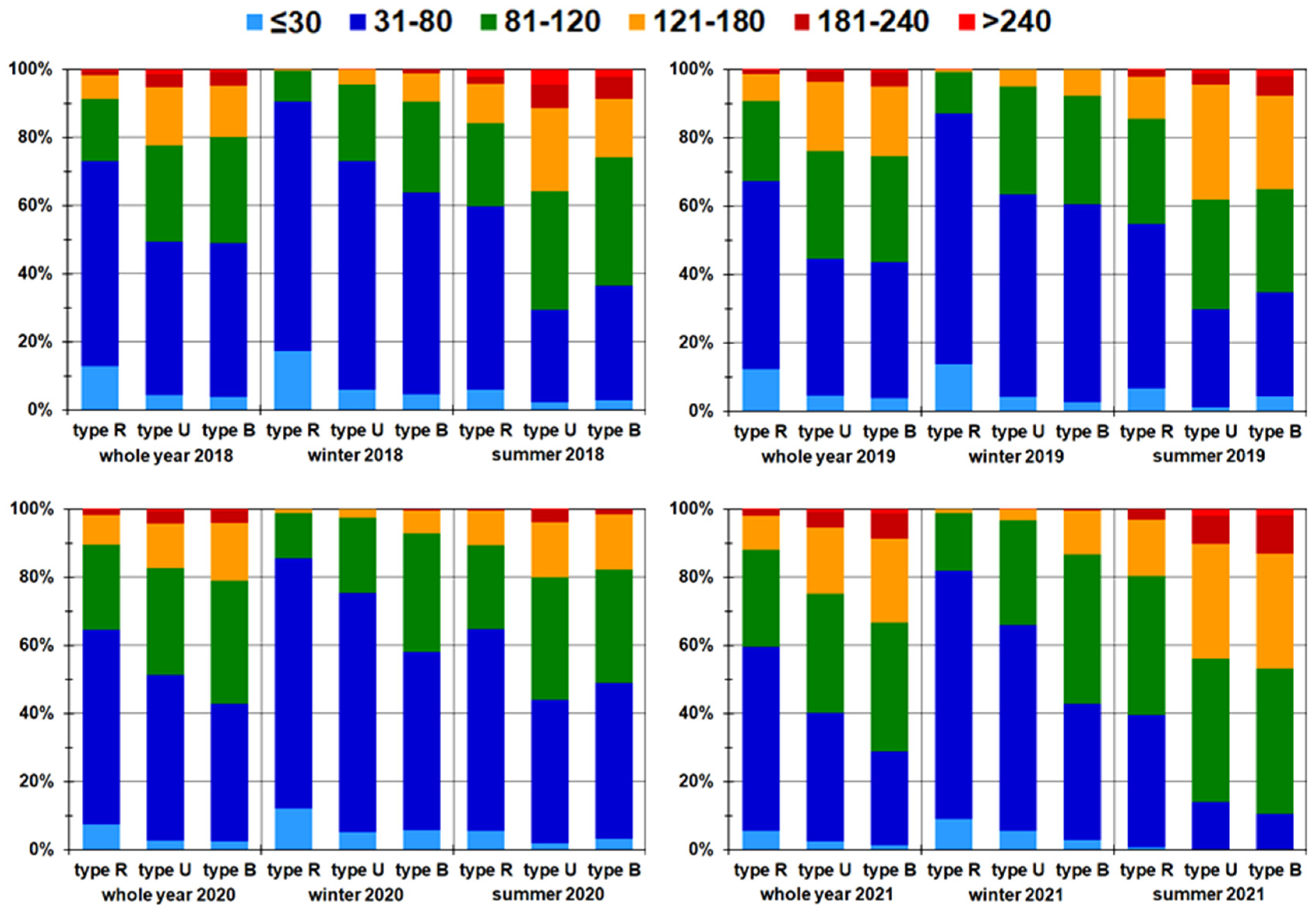
3.4.2. Frequencies of Daily Maximum 1 h NO2 Means
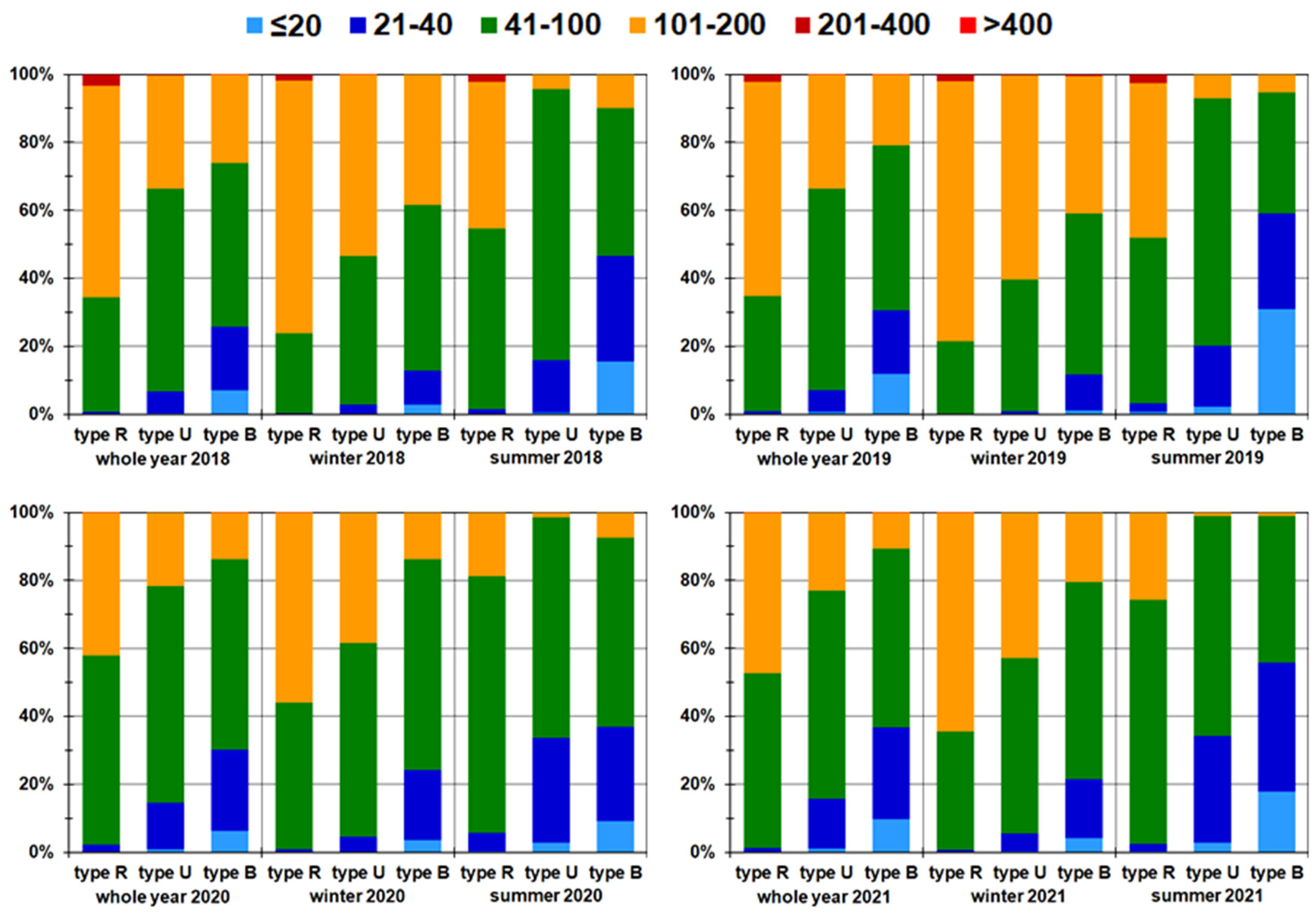
3.4.3. Frequencies of Daily 24 h PM10 Means
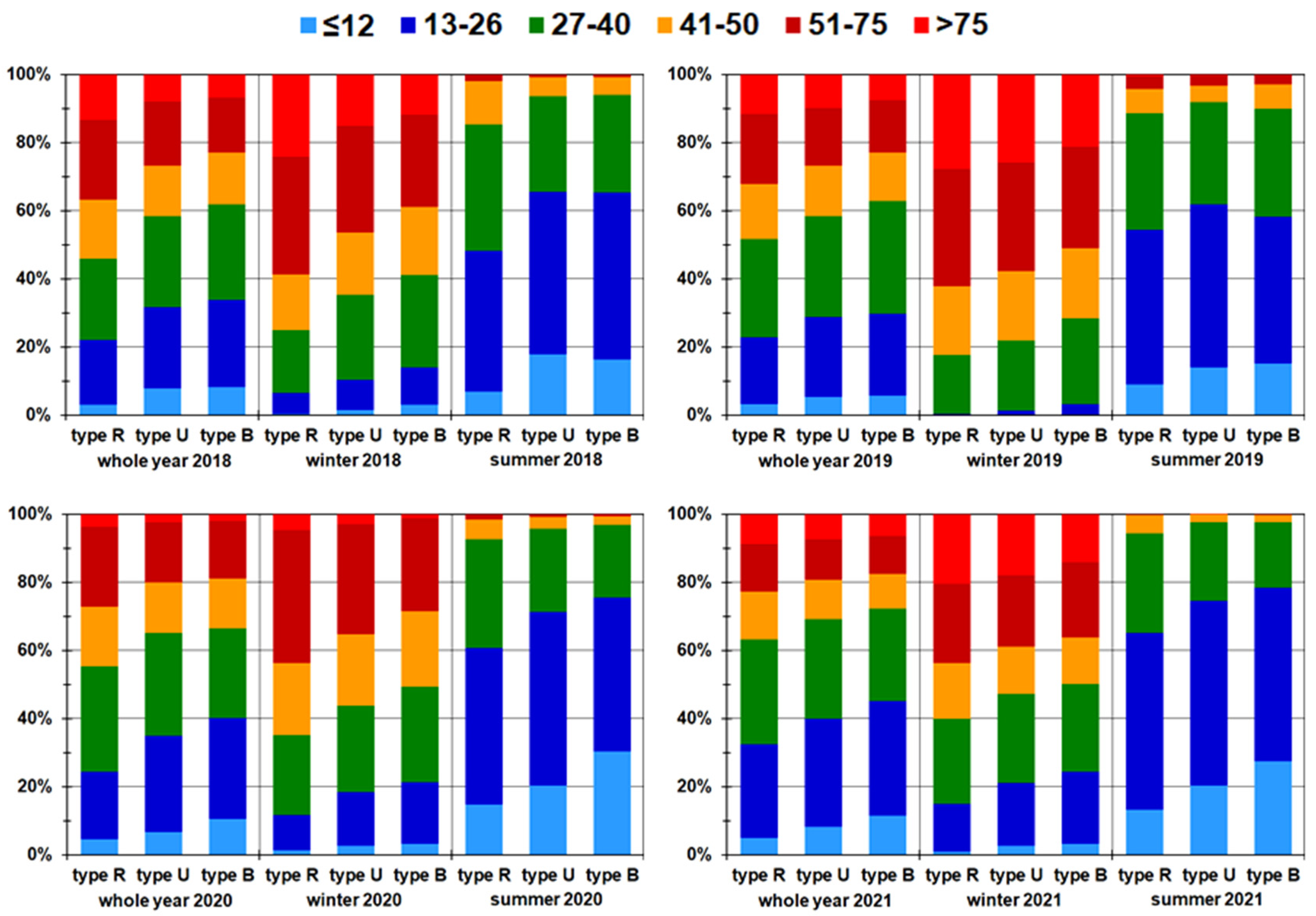
3.4.4. Frequencies of Daily 24 h PM2.5 Means
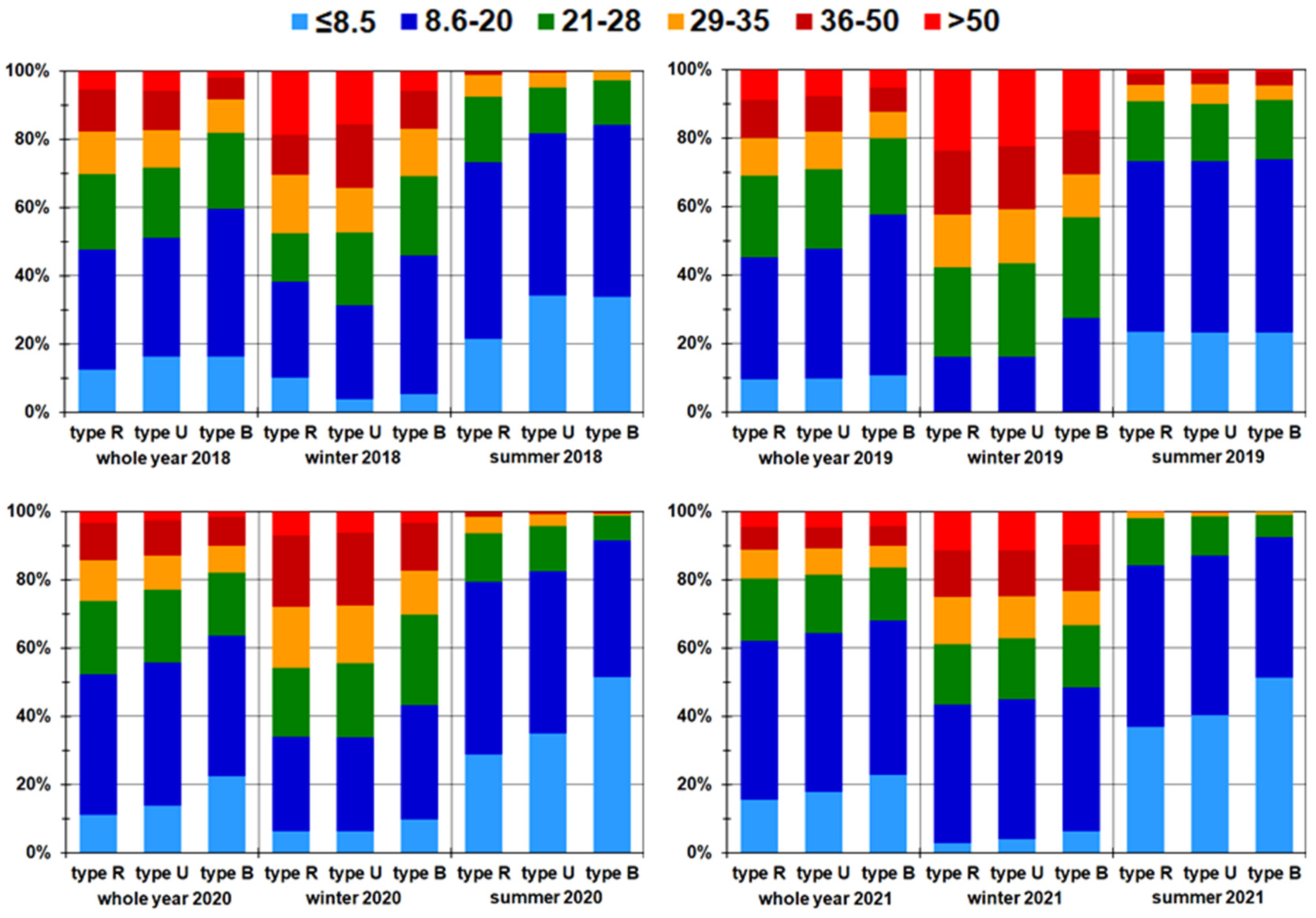
3.5. Variations of DAQx*-Relevant Air Pollutants within AQMS Types
3.5.1. Variations of Daily Maximum 1 h O3 Means

3.5.2. Variations of Daily Maximum 1 h NO2 Means
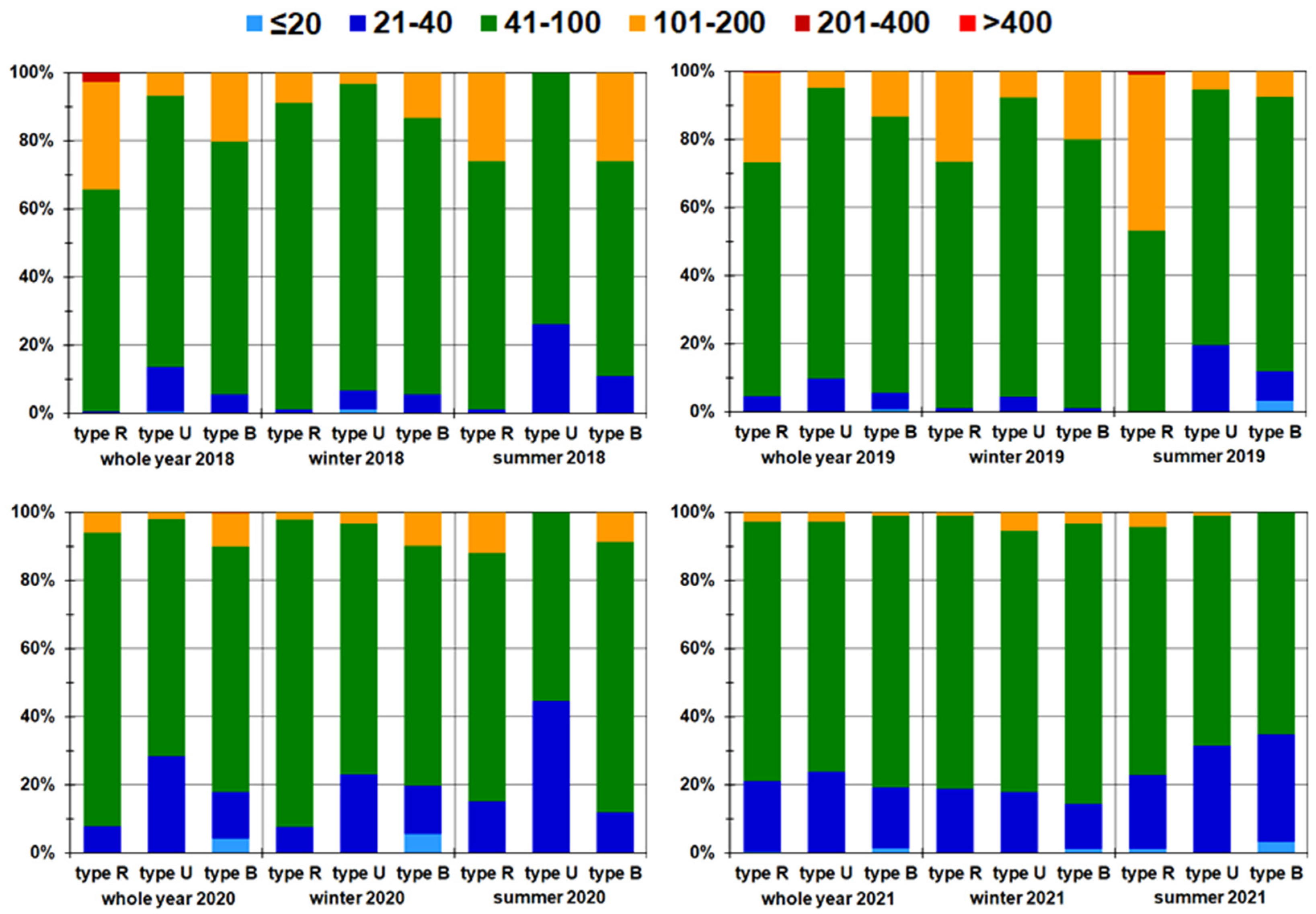
3.5.3. Variations of Daily 24 h PM10 Means
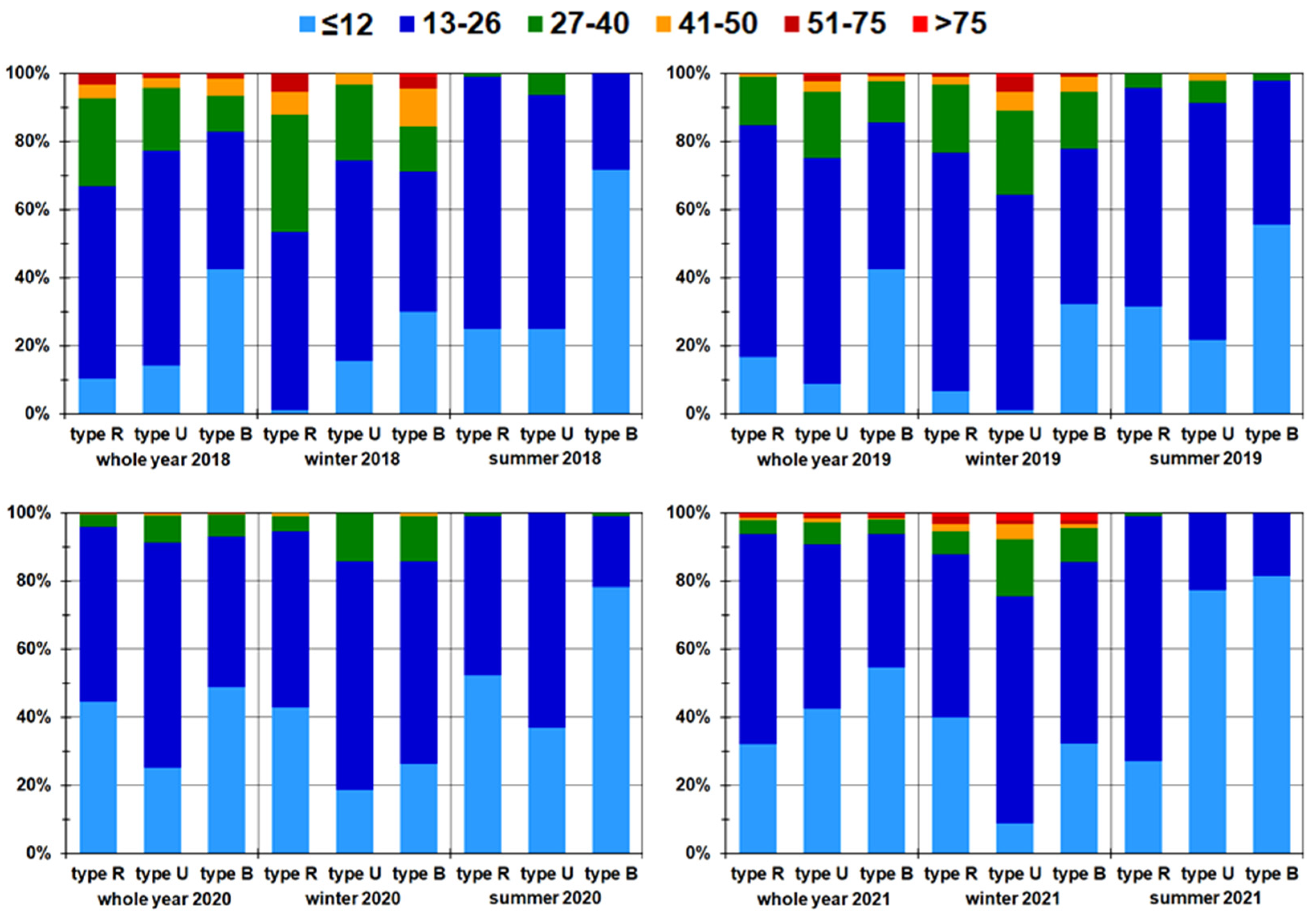
3.5.4. Variations of Daily 24 h PM2.5 Means
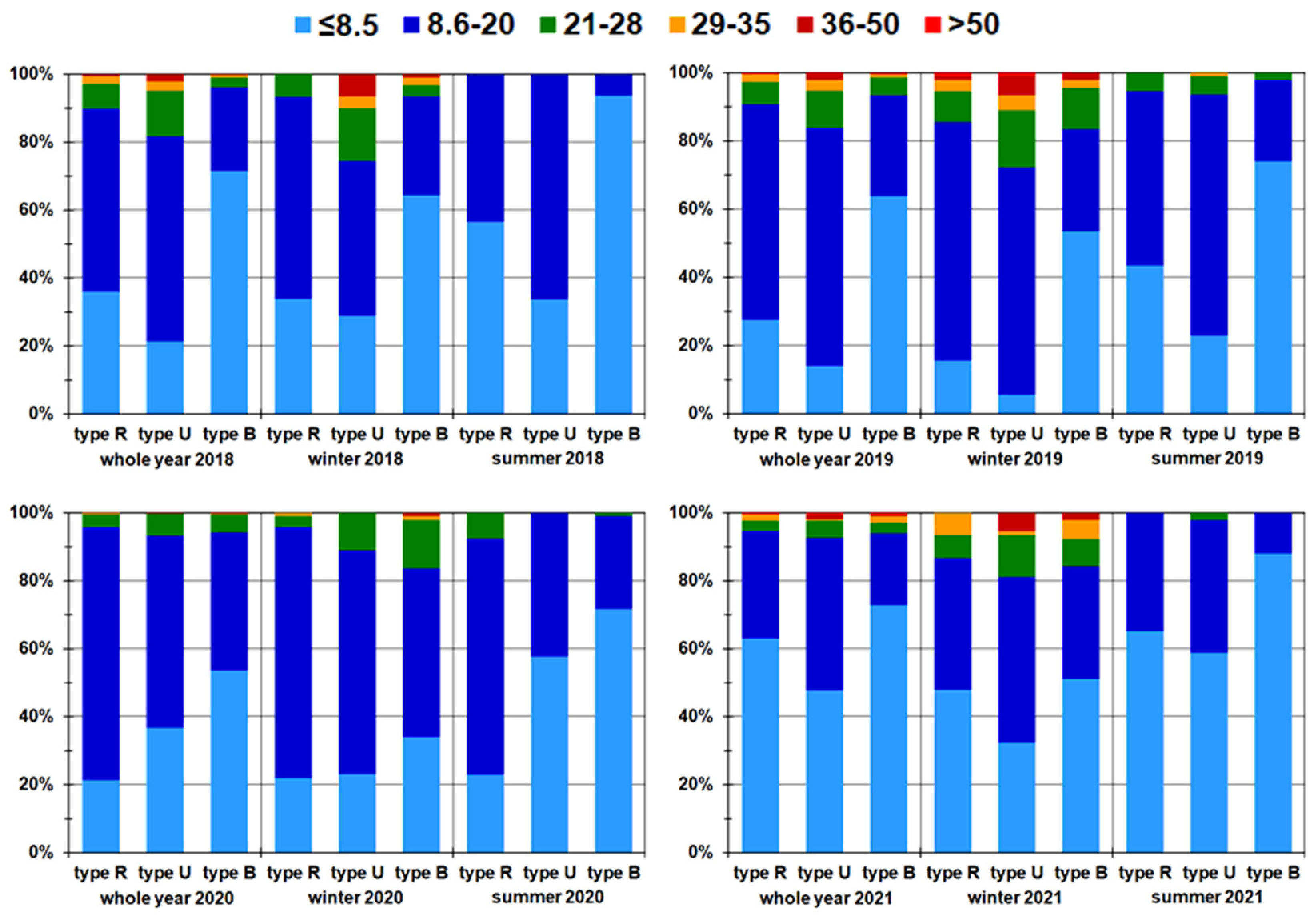
3.6. Social Distancing Effects
4. Discussion
5. Conclusions
Author Contributions
Funding
Institutional Review Board Statement
Informed Consent Statement
Data Availability Statement
Conflicts of Interest
Appendix A
| No. | Station | UTM Coordinates | Elevation asl (m) | Sampling Height agl (m) | O3 (µg/m3) | NO2 (µg/m3) | PM10 (µg/m3) | PM2.5 (µg/m3) |
|---|---|---|---|---|---|---|---|---|
| R1 | Jeongneung-ro | 325751, 4163666 | 76 | 2.8 | 60 | 111 | 38 | 21 |
| R2 | Sinchon-ro | 317829, 4158435 | 35 | 4.5 | 60 | 124 | 38 | 21 |
| R3 | Hangang-daero | 320811, 4157754 | 28 | 4.8 | 64 | 101 | 41 | 20 |
| R4 | Gangnam-daero | 326320, 4150253 | 27 | 3.0 | 64 | 109 | 37 | 18 |
| R5 | Dosan-daero | 324989, 4153968 | 25 | 3.0 | 68 | 90 | 38 | 19 |
| R6 | Jong-ro | 323093, 4160064 | 23 | 4.0 | 76 | 90 | 33 | 17 |
| R7 | Cheonggyecheon-ro | 323203, 4159841 | 22 | 3.7 | 78 | 96 | 36 | 22 |
| R8 | Gangbyeonbuk-ro | 326921, 4156503 | 21 | 3.0 | 62 | 109 | 36 | 19 |
| R9 | Gonghang-daero | 307995, 4159532 | 21 | 3.0 | 70 | 109 | 40 | 20 |
| R10 | Cheonho-daero | 335588, 4155744 | 20 | 4.7 | 74 | 108 | 40 | 19 |
| R11 | Hwarang-ro | 330118, 4165099 | 19 | 3.0 | 62 | 92 | 37 | 19 |
| R12 | Dongjak-daero | 321710, 4151376 | 11 | 3.0 | 64 | 115 | 39 | 19 |
| R13 | Yeongdeungpo-ro | 314859, 4154647 | 10 | 4.6 | 64 | 117 | 38 | 20 |
| No. | Station | UTM Coordinates | Elevation asl (m) | Sampling Height agl (m) | O3 (µg/m3) | NO2 (µg/m3) | PM10 (µg/m3) | PM2.5 (µg/m3) |
|---|---|---|---|---|---|---|---|---|
| U1 | Seodaemun-gu | 318976, 4162719 | 57 | 17.0 | 90 | 63 | 32 | 17 |
| U2 | Dobong-gu | 326163, 4169284 | 56 | 19.6 | 90 | 61 | 32 | 17 |
| U3 | Seocho-gu | 322745, 4152735 | 50 | 15.8 | 90 | 84 | 35 | 18 |
| U4 | Eunpyeong-gu | 317602, 4164605 | 43 | 9.3 | 98 | 63 | 33 | 19 |
| U5 | Yongsan-gu | 323307, 4156087 | 43 | 15.3 | 80 | 77 | 31 | 18 |
| U6 | Guro-gu | 313455, 4152267 | 40 | 16.9 | 92 | 75 | 34 | 18 |
| U7 | Jungnang-gu | 331737, 4161473 | 38 | 14.8 | 80 | 71 | 31 | 17 |
| U8 | Seongbuk-gu | 325869, 4164005 | 36 | 16.0 | 78 | 82 | 35 | 17 |
| U9 | Gwangjin-gu | 331772, 4156998 | 35 | 10.3 | 78 | 69 | 33 | 18 |
| U10 | Jung-gu | 321240, 4159438 | 32 | 18.8 | 86 | 85 | 33 | 19 |
| U11 | Gangdong-gu | 335404, 4156975 | 31 | 15.3 | 78 | 86 | 35 | 20 |
| U12 | Nowon-gu | 329570, 4169562 | 30 | 15.0 | 86 | 77 | 33 | 19 |
| U13 | Gangbuk-gu | 324615, 4168612 | 29 | 16.5 | 88 | 57 | 34 | 18 |
| U14 | Dongjak-gu | 320650, 4150165 | 28 | 12.6 | 82 | 82 | 36 | 19 |
| U15 | Songpa-gu | 331384, 4152348 | 24 | 17.5 | 88 | 86 | 33 | 18 |
| U16 | Geumcheon-gu | 314985, 4147111 | 23 | 13.1 | 84 | 86 | 33 | 20 |
| U17 | Jongno-gu | 323825, 4160205 | 21 | 19.3 | 84 | 82 | 32 | 18 |
| U18 | Gwanak-gu | 316736, 4151055 | 20 | 16.3 | 83 | 88 | 35 | 19 |
| U19 | Seongdong-gu | 327700, 4156792 | 20 | 15.8 | 84 | 82 | 34 | 19 |
| U20 | Gangseo-gu | 308746, 4157498 | 18 | 16.0 | 90 | 86 | 35 | 19 |
| U21 | Dongdaemun-gu | 326008, 4160617 | 17 | 16.0 | 84 | 84 | 31 | 18 |
| U22 | Mapo-gu | 314990, 4158573 | 17 | 15.8 | 82 | 78 | 34 | 19 |
| U23 | Yeongdeungpo-gu | 314104, 4155343 | 15 | 12.3 | 80 | 80 | 35 | 20 |
| U24 | Yangcheon-gu | 310777, 4155079 | 12 | 16.5 | 86 | 88 | 36 | 19 |
| No. | Station | UTM Coordinates | Elevation asl (m) | Sampling Height agl (m) | O3 (µg/m3) | NO2 (µg/m3) | PM10 (µg/m3) | PM2.5 (µg/m3) |
|---|---|---|---|---|---|---|---|---|
| B1 | Gwanaksan | 320162, 4145970 | 615 | 14.0 | 98 | 36 | 30 | 16 |
| B2 | Namsan | 322236, 4157923 | 255 | 7.8 | 94 | 69 | 31 | 17 |
| B3 | Bukhansan | 323835, 4172068 | 220 | 5.4 | 88 | 33 | 27 | 15 |
| B4 | Segok | 332617, 4148152 | 23 | 7.0 | 78 | 92 | 34 | 18 |
| B5 | Haengju | 304601, 4164745 | 9 | 8.0 | 90 | 78 | 37 | 18 |
| Air Pollutant | |||
|---|---|---|---|
| O3 | NO2 | PM10/PM2.5 | |
| Type from Kimoto Electric Co. | Ozone analyzer OA-781 | Nitrogen oxides analyzer NA-721 | Particulate matter monitor PM-711 |
| Sampling method | Ultraviolet adsorption method | Chemiluminescence method (CLD) | Beta ray attenuation method (JIS B B7954) |
| Measurement range | 0–1 ppm | 0–1 ppm | 0–5 mg/m3 |
| Detection limit | 0.05 ppb | 0.05 ppb | 0.1 µg/m3 |
| Period | Intensity Level |
|---|---|
| 29 February 2020 to 21 March 2020 | start social distancing |
| 22 March 2020 to 19 April 2020 | stronger social distancing |
| 20 April 2020 to 18 August 2020 | normal social distancing |
| 19 August 2020 to 11 October 2020 | stronger social distancing |
| 12 October 2020 to 18 November 2020 | normal social distancing |
| 19 November 2020 to 23 November 2020 | social distancing (level 1.5) |
| 24 November 2020 to 5 December 2020 | social distancing (level 2.0) |
| 6 December 2020 to 14 February 2021 | social distancing (level 2.5) |
| 15 February 2021 to 30 June 2021 | social distancing (level 2.0) |
| 1 July 2021 to 11 July 2021 | social distancing (level 3) |
| 12 July 2021 to 31 October 2021 | social distancing (level 4) |
| 1 November 2021 to 17 December 2021 | social distancing (“with corona”) |
References
- Mayer, H. Air pollution in cities. Atmos. Environ. 1999, 33, 4029–4037. [Google Scholar] [CrossRef]
- Chen, W.; Tang, H.; Zhao, H. Diurnal, weekly and monthly spatial variations of air pollutants and air quality of Beijing. Atmos. Environ. 2015, 119, 21–34. [Google Scholar] [CrossRef]
- Campos, P.M.D.; Esteves, A.F.; Leitão, A.A.; Pires, J.C.M. Design of air quality monitoring network of Luanda, Angola: Urban air pollution assessment. Atmos. Pollut. Res. 2021, 12, 101128. [Google Scholar] [CrossRef]
- Chiarini, B.; D’Agostino, A.; Marzano, E.; Regoli, A. Air quality in urban areas: Comparing objective and subjective indicators in European countries. Ecol. Indic. 2021, 121, 107144. [Google Scholar] [CrossRef]
- Sicard, P.; Agathokleous, E.; De Marco, A.; Paoletti, E.; Calatayud, V. Urban population exposure to air pollution in Europe over the last decades. Environ. Sci. Eur. 2021, 33, 28. [Google Scholar] [CrossRef]
- Kim, Y.P.; Lee, G. Trend of air quality in Seoul: Policy and science. Aerosol. Air Qual. Res. 2018, 18, 2141–2156. [Google Scholar] [CrossRef]
- van den Elshout, S.; Léger, K.; Nussio, F. Comparing urban air quality in Europe in real time. A review of existing air quality indices and the proposal of a common alternative. Environ. Int. 2008, 34, 720–726. [Google Scholar] [CrossRef]
- Plaia, A.; Ruggieri, M. Air quality indices: A review. Rev. Environ. Sci. Biotechnol. 2011, 10, 165–179. [Google Scholar] [CrossRef]
- Dimitriou, K.; Paschalidou, A.K.; Kassomenos, P.A. Assessing air quality with regards to its effect on human health in the European Union through air quality indices. Ecol. Indic. 2013, 27, 108–115. [Google Scholar] [CrossRef]
- Tan, X.; Han, L.; Zhang, X.; Zhou, W.; Li, W.; Qian, Y. A review of current air quality indexes and improvements under the multi-contaminant air pollution exposure. J. Environ. Manag. 2021, 279, 111681. [Google Scholar] [CrossRef]
- Fung, P.L.; Sillanpää, S.; Niemi, J.V.; Kousa, A.; Timonen, H.; Zaidan, M.A.; Saukko, E.; Kulmala, M.; Petäjä, T.; Hussein, T. Improving the current air quality index with new particulate indicators using a robust statistical approach. Sci. Total Environ. 2022, 844, 157099. [Google Scholar] [CrossRef] [PubMed]
- Baklanov, A.; Molina, L.T.; Gauss, M. Megacities, air quality and climate. Atmos. Environ. 2016, 126, 235–249. [Google Scholar] [CrossRef]
- Elansky, N.F.; Shilkin, A.V.; Ponomarev, N.A.; Semutnikova, E.G.; Zakharova, P.V. Weekly patterns and weekend effects of air pollution in the Moscow megacity. Atmos. Environ. 2020, 224, 117303. [Google Scholar] [CrossRef]
- Lee, T.; Go, S.; Lee, Y.G.; Park, S.S.; Park, J.; Koo, J.-H. Temporal variability of surface air pollutants in megacities of South Korea. Front. Environ. Sci. 2022, 10, 915531. [Google Scholar] [CrossRef]
- Mayer, H.; Makra, L.; Kalberlah, F.; Ahrens, D.; Reuter, U. Air stress and air quality indices. Meteorol. Z 2004, 13, 395–403. [Google Scholar] [CrossRef]
- Bierwisch, A.; Voss, J.-U.; Schwarz, M.; Kalberlah, F. Air Quality Index Baden-Württemberg (LQIBW)—Update for the Year 2020 (In German); Baden-Württemberg State Institute for the Environment: Karlsruhe, Germany, 2020; Available online: https://pudi.lubw.de/detailseite/-/publication/10100 (accessed on 19 January 2023).
- Holst, J.; Mayer, H.; Holst, T. Effect of meteorological exchange conditions on PM10 concentration. Meteorol. Z 2008, 17, 273–282. [Google Scholar] [CrossRef]
- Rost, J.; Holst, T.; Sähn, E.; Klingner, M.; Anke, K.; Ahrens, D.; Mayer, H. Variability of PM10 concentrations dependent on meteorological conditions. Int. J. Environ. Pollut. 2009, 36, 3–18. [Google Scholar] [CrossRef]
- Makra, L.; Mayer, H.; Mika, J.; Sánta, T.; Holst, J. Variations of traffic related air pollution on different time scales in Szeged, Hungary and Freiburg, Germany. Phys. Chem. Earth 2010, 35, 85–94. [Google Scholar] [CrossRef]
- Choi, K.-C.; Lee, J.-J.; Bae, C.H.; Kim, C.-H.; Kim, S.; Chang, L.-S.; Ban, S.-J.; Lee, S.-J.; Kim, J.; Woo, J.-H. Assessment of transboundary ozone contribution toward South Korea using multiple source-receptor modeling techniques. Atmos. Environ. 2014, 92, 118–129. [Google Scholar] [CrossRef]
- Schiavon, M.; Redivo, M.; Antonacci, G.; Rada, E.C.; Ragazzi, M.; Zardi, D.; Giovannini, L. Assessing the air quality impact of nitrogen oxides and benzene from road traffic and domestic heating and the associated cancer risk in an urban area of Verona (Italy). Atmos. Environ. 2015, 120, 234–243. [Google Scholar] [CrossRef]
- Jeong, U.; Kim, J.; Lee, H.; Lee, Y.G. Assessing the effect of long-range pollutant transportation on air quality in Seoul using the conditional potential source contribution function method. Atmos. Environ. 2017, 150, 33–44. [Google Scholar] [CrossRef]
- Kim, H.C.; Kim, E.; Bae, C.; Cho, J.H.; Kim, B.-U.; Kim, S. Regional contributions to particulate matter concentration in the Seoul metropolitan area, South Korea: Seasonal variation and sensitivity to meteorology and emissions inventory. Atmos. Chem. Phys. 2017, 17, 10315–10332. [Google Scholar] [CrossRef]
- Schiavon, M.; Ragazzi, M.; Rada, E.C.; Magaril, E.; Torretta, V. Towards the sustainable management of air quality and human exposure: Exemplary case studies. WIT Trans. Ecol. Environ. 2018, 230, 489–500. [Google Scholar]
- Bae, C.; Kim, B.-U.; Kim, H.C.; Yoo, C.; Kim, S. Long-range transport influence on key chemical components of PM2.5 in the Seoul Metropolitan Area, South Korea, during the years 2012–2016. Atmosphere 2020, 11, 48. [Google Scholar] [CrossRef]
- Jeong, Y.; Lee, H.W.; Jeon, W. Regional differences of primary meteorological factors impacting O3 variability in South Korea. Atmosphere 2020, 11, 74. [Google Scholar] [CrossRef]
- Zhou, D.; Lin, Z.; Liu, L.; Qi, J. Spatial-temporal characteristics of urban air pollution in 337 Chinese cities and their influencing factors. Environ. Sci. Pollut. Res. 2021, 28, 36234–36258. [Google Scholar] [CrossRef]
- Allabakash, S.; Lim, S.; Chong, K.-S.; Yamada, T.J. Particulate matter concentrations over South Korea: Impact of meteorology and other pollutants. Remote Sens. 2022, 14, 4849. [Google Scholar] [CrossRef]
- Kim, H. Land use impacts on particulate matter levels in Seoul, South Korea: Comparing high and low seasons. Land 2020, 9, 142. [Google Scholar] [CrossRef]
- Ahn, H.; Lee, J.; Hong, A. Urban form and air pollution: Clustering patterns of urban form factors related to particulate matter in Seoul, Korea. Sustain. Cities Soc. 2022, 81, 103859. [Google Scholar] [CrossRef]
- Kim, H.; Hong, S. Relationship between land-use type and daily concentration and variability of PM10 in Metropolitan Cities: Evidence from South Korea. Land 2022, 11, 23. [Google Scholar] [CrossRef]
- Li, Y.; Hong, T.; Gu, Y.; Li, Z.; Huang, T.; Lee, H.F.; Heo, Y.; Yim, S.H.L. Assessing the spatiotemporal characteristics, factor importance, and health impacts of air pollution in Seoul by integrating machine learning into land-use regression modeling at high spatiotemporal resolutions. Environ. Sci. Technol. 2023, 57, 1225–1236. [Google Scholar] [CrossRef] [PubMed]
- Monteiro, A.; Viera, M.; Gama, C.; Miranda, A.I. Towards an improved air quality index. Air Qual. Atmos. Health 2017, 10, 447–455. [Google Scholar] [CrossRef]
- Karavas, Z.; Karayannis, V.; Moustakas, K. Comparative study of air quality indices in the European Union towards adopting a common air quality index. Energy Environ. 2021, 32, 959–980. [Google Scholar] [CrossRef]
- Mayer, H.; Kalberlah, F. Two impact related air quality indices as tools to assess the daily and long-term air pollution. Int. J. Environ. Pollut. 2009, 36, 19–29. [Google Scholar] [CrossRef]
- Lee, H.; Lee, J.; Oh, S.; Park, S.; Mayer, H. Air pollution assessment in Seoul, South Korea, using an updated daily air quality index. Atmos. Pollut. Res. 2023, 14, 101728. [Google Scholar] [CrossRef]
- Chambers, S.D.; Kim, K.-H.; Kwon, E.E.; Brown, R.J.C.; Griffiths, A.D.; Crawford, J. Statistical analysis of Seoul air quality to assess the efficacy of emission abatement strategies since 1987. Sci. Total Environ. 2017, 580, 105–116. [Google Scholar] [CrossRef]
- Kim, N.-K.; Kim, Y.-P.; Shin, H.-J.; Lee, J.-Y. Long-term trend of the levels of ambient air pollutants of a megacity and a background area in Korea. Appl. Sci. 2022, 12, 4039. [Google Scholar] [CrossRef]
- Yeo, M.J.; Kim, Y.P. Long-term trends and affecting factors in the concentrations of criteria air pollutants in South Korea. J. Environ. Manag. 2022, 317, 115458. [Google Scholar] [CrossRef]
- Park, S.-H.; Ko, D.-W. Investigating the effects of the built environment on PM2.5 and PM10: A case study of Seoul Metropolitan City, South Korea. Sustainability 2018, 10, 4552. [Google Scholar] [CrossRef]
- Kim, Y.-M.; Oh, I.; Kim, J.; Kang, Y.-H.; Ahn, K. Harmful effects of ambient nitrogen dioxide on atopic dermatitis: Comparison of exposure assessment based on monitored concentrations and modeled estimates. Atmosphere 2020, 11, 921. [Google Scholar] [CrossRef]
- Shim, C.; Han, J.; Henze, D.K.; Shephard, M.W.; Zhu, L.; Moon, N.; Kharol, S.K.; Dammers, E.; Cady-Pereira, K. Impact of NH3 emissions on particulate matter pollution in South Korea: A case study of the Seoul Metropolitan Area. Atmosphere 2022, 13, 1227. [Google Scholar] [CrossRef]
- Gope, S.; Dawn, S.; Das, S.S. Effect of COVID-19 pandemic on air quality: A study based on air quality index. Environ. Sci. Pollut. Res. 2021, 28, 35564–35583. [Google Scholar] [CrossRef]
- K-eco. Air Quality and Environment Management; Korea Environment Cooperation: Incheon, Republic of Korea, 2022; Available online: https://www.keco.or.kr/en/core/climate_air1/contentsid/1946/index.do (accessed on 28 December 2022).
- Kumbhakar, S.C.; An, J.; Rashidghalam, M.; Heshmati, A. Efficiency in reducing air pollutants and healthcare expenditure in the Seoul Metropolitan City of South Korea. Environ. Sci. Pollut. Res. 2021, 28, 25442–25459. [Google Scholar] [CrossRef] [PubMed]
- Yang, G.; Lee, H.M.; Lee, G. A hybrid deep learning model to forecast particulate matter concentration levels in Seoul, South Korea. Atmosphere 2020, 11, 348. [Google Scholar] [CrossRef]
- Nguyen, H.T.; Kim, K.-H.; Park, C. Long-term trend of NO2 in major urban areas of Korea and possible consequences for health. Atmos. Environ. 2015, 106, 347–357. [Google Scholar] [CrossRef]
- Kim, Y.; Guldmann, J.-M. Land-use regression panel models of NO2 concentrations in Seoul, Korea. Atmos. Environ. 2015, 107, 364–373. [Google Scholar] [CrossRef]
- MOHW. Coronavirus (COVID-19), Republic of Korea. Central Disaster and Safety Countermeasures Headquarters; Ministry of Health & Welfare: Sejong-si, Republic of Korea, 2022. Available online: https://ncov.kdca.go.kr/en/ (accessed on 28 December 2022).
- Seo, J.H.; Jeon, H.W.; Sung, U.J.; Sohn, J.-R. Impact of the COVID-19 outbreak on air quality in Korea. Atmosphere 2020, 11, 1137. [Google Scholar] [CrossRef]
- Ju, M.J.; Oh, J.; Choi, Y.-H. Changes in air pollution levels after COVID-19 outbreak in Korea. Sci. Total Environ. 2021, 750, 141521. [Google Scholar] [CrossRef] [PubMed]
- SMG. Big Data Seoul. Seoul Metropolitan Government: Seoul, Republic of Korea, 2022. Available online: https://data.seoul.go.kr/dataVisual/seoul/seoulLivingPopulation.do (accessed on 28 December 2022).
- Hwang, H.; Lee, J.Y. Impacts of COVID-19 on air quality through traffic reduction. Int. J. Environ. Res. Public Health 2022, 19, 1718. [Google Scholar] [CrossRef]
- Mayer, H.; Schmidt, J. Trend analysis of time series of air pollutants in Baden-Württemberg and Bayern (Germany). Meteorol. Z 1994, 3, 116–121. [Google Scholar] [CrossRef]
- Kim, J.; Lee, J.; Han, J.-S.; Choi, J.; Kim, D.-G.; Park, J.; Lee, G. Long-term assessment of ozone nonattainment changes in South Korea compared to US, and EU ozone guidelines. Asian J. Atmos. Environ. 2021, 15, 2021098. [Google Scholar] [CrossRef]
- Mayer, H.; Holst, J.; Schindler, D.; Ahrens, D. Evolution of the air pollution in SW Germany evaluated by the long-term air quality index LAQx. Atmos. Environ. 2008, 42, 5071–5078. [Google Scholar] [CrossRef]
- Kwak, K.-H.; Ryu, Y.-H.; Baik, J.-J. Temporal and spatial variations of NOx and ozone concentrations in Seoul during the solar eclipse of 22 July 2009. J. Appl. Meteorol. Climatol. 2011, 50, 500–506. [Google Scholar] [CrossRef]
- Ahmed, E.; Kim, K.-H.; Shon, Z.-H.; Song, S.-K. Long-term trend of airborne particulate matter in Seoul, Korea from 2004 to 2013. Atmos. Environ. 2015, 101, 125–133. [Google Scholar] [CrossRef]
- Oh, H.-R.; Ho, C.-H.; Kim, J.; Chen, D.; Lee, S.; Choi, Y.-S.; Chang, L.-S.; Song, C.-K. Long-range transport of air pollutants originating in China: A possible major cause of multi-day high-PM10 episodes during cold season in Seoul, Korea. Atmos. Environ. 2015, 109, 23–30. [Google Scholar] [CrossRef]
- Park, S.; El-Askary, H.; Sabbah, I.; Kwak, H.; Prasad, A.K.; Lee, W.-K.; Kafatos, M. Studying air pollutants origin and associated meteorological parameters over Seoul from 2000 to 2009. Adv. Meteorol. 2015, 2015, 704178. [Google Scholar] [CrossRef]
- Yoo, J.-M.; Jeong, M.-J.; Kim, D.; Stockwell, W.R.; Yang, J.-H.; Shin, H.-W.; Lee, M.-I.; Song, C.-K.; Lee, S.-D. Spatiotemporal variations of air pollutants (O3, NO2, SO2, CO, PM10, and VOCs) with land-use types. Atmos. Chem. Phys. 2015, 15, 10857–10885. [Google Scholar] [CrossRef]
- Vellingiri, K.; Kim, K.-H.; Lim, J.-M.; Lee, J.-H.; Ma, C.-J.; Jeon, B.-H.; Sohn, J.-R.; Kumar, P.; Kang, C.-H. Identification of nitrogen dioxide and ozone source regions for an urban area in Korea using back trajectory analysis. Atmos. Res. 2016, 176–177, 212–221. [Google Scholar] [CrossRef]
- Wie, J.; Moon, B.-K. Seasonal relationship between meteorological conditions and surface ozone in Korea based on an offline chemistry-climate model. Atmos. Pollut. Res. 2016, 7, 385–392. [Google Scholar] [CrossRef]
- Kim, H.C.; Kim, S.; Kim, B.-U.; Jin, C.-S.; Hong, S.; Park, R.; Son, S.-W.; Bae, C.; Song, C.-K.; Stein, A. Recent increase of surface particulate matter concentrations in the Seoul Metropolitan Area, Korea. Sci. Rep. 2017, 7, 4710. [Google Scholar] [CrossRef]
- Seo, J.; Park, D.-S.R.; Kim, J.Y.; Youn, D.; Lim, Y.B.; Kim, Y. Effects of meteorology and emissions on urban air quality: A quantitative statistical approach to long-term records (1999–2016) in Seoul, South Korea. Atmos. Chem. Phys. 2018, 18, 16121–16137. [Google Scholar] [CrossRef]
- Szulejko, J.E.; Adelodun, A.A.; Kim, K.-H.; Seo, J.W.; Vellingiri, K.; Jeon, E.-C.; Hong, J.; Brown, R.J.C. Short and long-term temporal changes in air quality in a Seoul urban area: The weekday/Sunday effect. Sustainability 2018, 10, 1248. [Google Scholar] [CrossRef]
- Lee, D.; Choi, J.-Y.; Myoung, J.; Kim, O.; Park, J.; Shin, H.-J.; Ban, S.-J.; Park, H.-J.; Nam, K.-P. Analysis of a severe PM2.5 episode in the Seoul Metropolitan Area in South Korea from 27 February to 7 March 2019: Focused on estimation of domestic and foreign contribution. Atmosphere 2019, 10, 756. [Google Scholar] [CrossRef]
- Lim, C.C.; Kim, H.; Ruzmyn Vilcassim, M.J.; Thurston, G.D.; Gordon, T.; Chen, L.-C.; Lee, K.; Heimbinder, M.; Kim, S.-Y. Mapping urban air quality using mobile sampling with low-cost sensors and machine learning in Seoul, South Korea. Environ. Int. 2019, 131, 105022. [Google Scholar] [CrossRef]
- Park, S.K. Assessing the impact of ozone and particulate matter on mortality rate from respiratory disease in Seoul, Korea. Atmosphere 2019, 10, 685. [Google Scholar] [CrossRef]
- Yang, S.H.; Jeong, J.I.; Park, R.J.; Kim, M.J. Impact of meteorological changes on particulate matter and aerosol optical depth in Seoul during the months of June over recent decades. Atmosphere 2020, 11, 1282. [Google Scholar] [CrossRef]
- Kim, J.-M.; Lee, H.-J.; Jo, H.-Y.; Jo, Y.-J.; Kim, C.-H. Vertical characteristics of secondary aerosols observed in the Seoul and Busan Metropolitan Areas of Korea during KORUS-AQ and associations with meteorological conditions. Atmosphere 2021, 12, 1451. [Google Scholar] [CrossRef]
- Park, D.S.; Choi, H.-J.; Chae, C.-B.; Kang, M.-S.; Kim, J.-H.; Lee, E.-A.; Chung, Y.-B.; Sunwoo, Y. Analysis of high-concentration PM2.5 episodes during winter 2019–2020 in Seoul, Korea. Asian J. Atmos. Environ. 2021, 15, 2021095. [Google Scholar] [CrossRef]
- Park, S.K. Seasonal variations of fine particulate matter and mortality rate in Seoul, Korea with a focus on the short-term impact of meteorological extremes on human health. Atmosphere 2021, 12, 151. [Google Scholar] [CrossRef]
- Han, S.; Park, Y.; Noh, N.; Kim, J.-H.; Kim, J.-J.; Kim, B.-M.; Choi, W. Spatiotemporal variability of the PM2.5 distribution and weather anomalies during severe pollution events: Observations from 462 air quality monitoring stations across South Korea. Atmos. Pollut. Res. 2023, 14, 101676. [Google Scholar] [CrossRef]
- Lee, S.; Kim, J.; Choi, M.; Hong, J.; Lim, H.; Eck, T.F.; Holben, B.N.; Ahn, J.-Y.; Kim, J.; Koo, J.-H. Analysis of long-range transboundary transport (LRTT) effect on Korean aerosol pollution during the KORUS-AQ campaign. Atmos. Environ. 2019, 204, 53–67. [Google Scholar] [CrossRef]
- Lee, S.; Kim, M.; Kim, S.-Y.; Lee, D.-W.; Lee, H.; Kim, J.; Le, S.; Liu, Y. Assessment of long-range transboundary aerosols in Seoul, South Korea from Geostationary Ocean Color Imager (GOCI) and ground-based observations. Environ. Pollut. 2021, 269, 115924. [Google Scholar] [CrossRef] [PubMed]
- Han, B.-S.; Park, K.; Kwak, K.-H.; Park, S.-B.; Jin, H.-G.; Moon, S.; Kim, J.-W.; Baik, J.-J. Air quality change in Seoul, South Korea under COVID-19 social distancing: Focusing on PM2.5. Int. J. Environ. Res. Public Health 2020, 17, 6208. [Google Scholar] [CrossRef] [PubMed]
- Park, H.; Jeong, S.; Koo, J.-H.; Sim, S.; Bae, Y.; Kim, Y.; Park, C.; Bang, J. Lessons from COVID-19 and Seoul: Effects of reduced human activity from social distancing on urban CO2 concentration and air quality. Aerosol. Air Qual. Res. 2020, 21, 200376. [Google Scholar] [CrossRef]
- Park, D.-H.; Kim, S.-W.; Kim, M.-H.; Yeo, H.; Park, S.S.; Nishizawa, T.; Shimizu, A.; Kim, C.-H. Impacts of local versus long-range transported aerosols on PM10 concentrations in Seoul, Korea: An estimate based on 11-year PM10 and lidar observations. Sci. Total Environ. 2021, 750, 141739. [Google Scholar] [CrossRef]
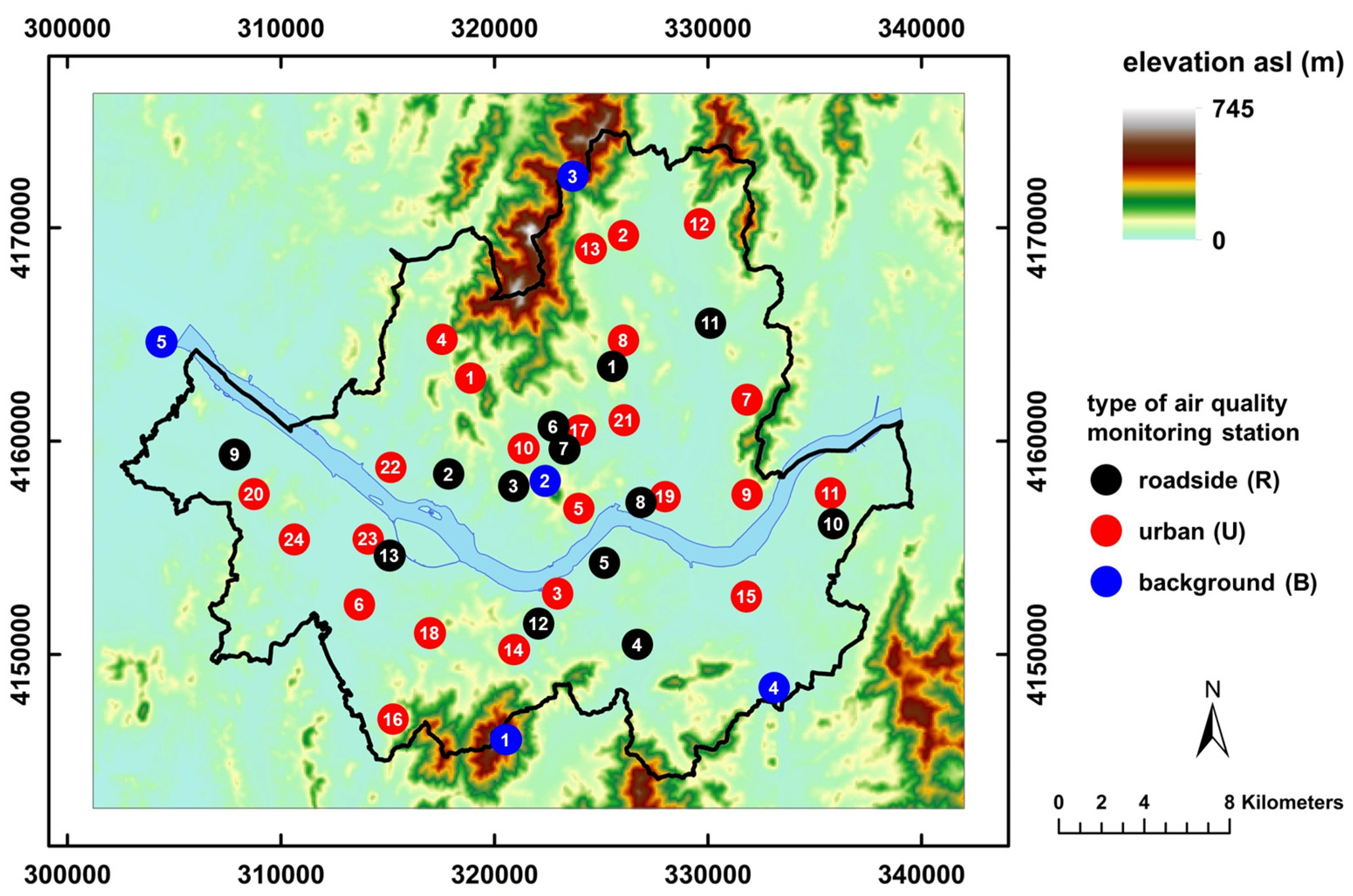
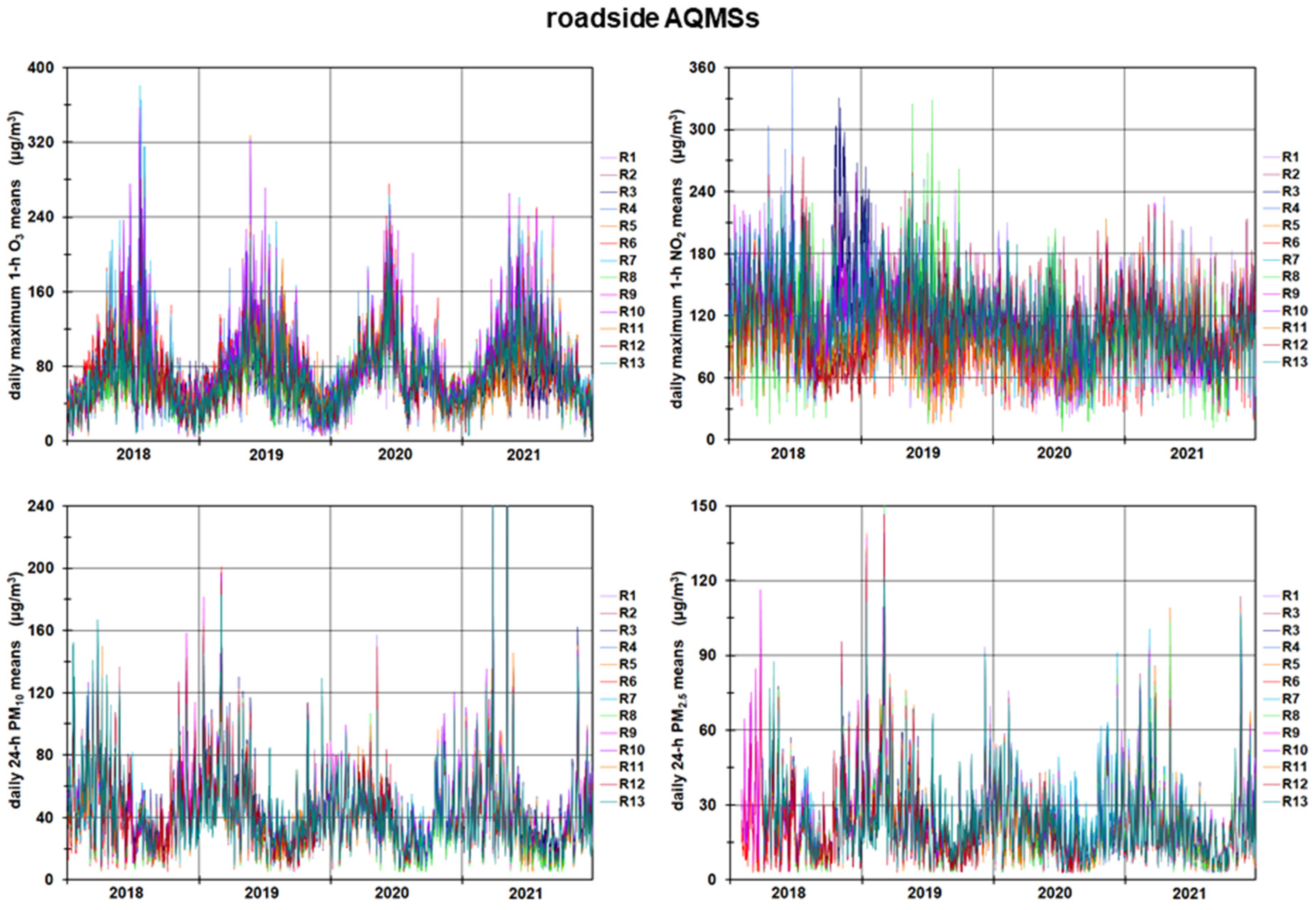

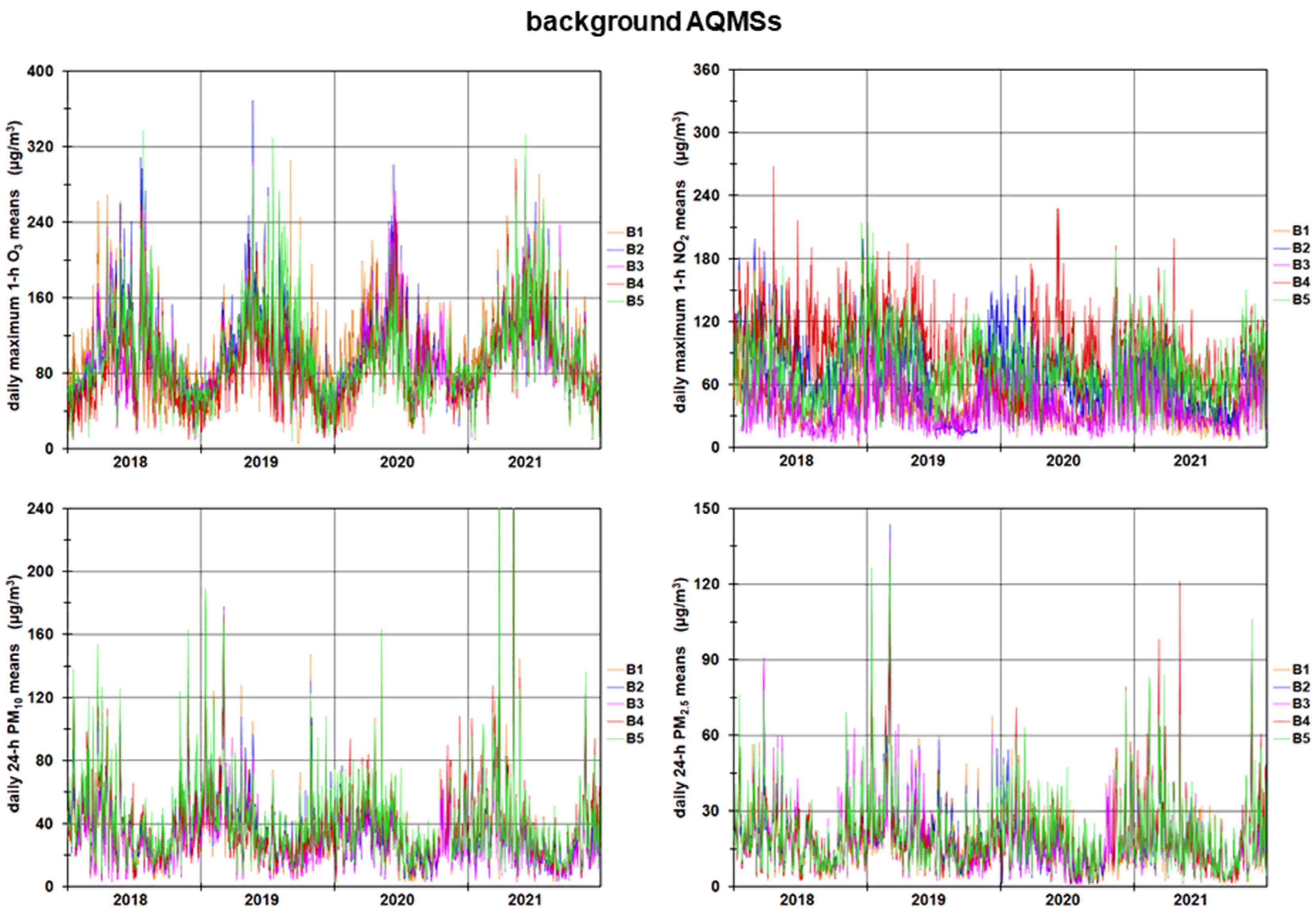
| O3 | NO2 | PM10 | PM2.5 | DAQx* Classes | Class Names | DAQx* Values |
|---|---|---|---|---|---|---|
| 0–30 | 0–20 | 0–12 | 0–8.5 | 1 | very good | <1.5 |
| 31–80 | 21–40 | 13–26 | 8.6–20 | 2 | good | 1.5–2.4 |
| 81–120 | 41–100 | 27–40 | 21–28 | 3 | satisfying | 2.5–3.4 |
| 121–180 | 101–200 | 41–50 | 29–35 | 4 | sufficient | 3.5–4.4 |
| 181–240 | 201–400 | 51–75 | 36–50 | 5 | poor | 4.5–5.4 |
| >240 | >400 | >75 | >50 | 6 | very poor | >5.4 |
| Air Pollutant | Type of AQMSs | 2018 | 2019 | 2020 | 2021 |
|---|---|---|---|---|---|
| daily max. 1 h O3 means | roadside | 60 | 64 | 68 | 72 |
| urban | 82 | 88 | 80 | 92 | |
| background | 82 | 88 | 86 | 102 | |
| daily max. 1 h NO2 means | roadside | 117 | 113 | 94 | 98 |
| urban | 84 | 86 | 69 | 69 | |
| background | 67 | 63 | 57 | 52 | |
| daily 24 h PM10 means | roadside | 42 | 39 | 37 | 33 |
| urban | 36 | 36 | 33 | 30 | |
| background | 34 | 34 | 31 | 28 | |
| daily 24 h PM2.5 means | roadside | 21 | 21 | 19 | 17 |
| urban | 20 | 21 | 18 | 16 | |
| background | 17 | 18 | 16 | 15 |
| Air Pollutant | Type of AQMSs | 2018 | 2019 | 2020 | 2021 |
|---|---|---|---|---|---|
| daily max. 1 h O3 means | roadside | 122 | 120 | 122 | 122 |
| urban | 151 | 140 | 138 | 142 | |
| background | 146 | 146 | 130 | 142 | |
| daily max. 1 h NO2 means | roadside | 133 | 121 | 107 | 103 |
| urban | 113 | 111 | 106 | 105 | |
| background | 128 | 119 | 105 | 98 | |
| daily 24 h PM10 means | roadside | 83 | 82 | 59 | 78 |
| urban | 77 | 80 | 58 | 77 | |
| background | 73 | 72 | 57 | 72 | |
| daily 24 h PM2.5 means | roadside | 45 | 55 | 40 | 43 |
| urban | 48 | 53 | 40 | 44 | |
| background | 36 | 45 | 38 | 43 |
Disclaimer/Publisher’s Note: The statements, opinions and data contained in all publications are solely those of the individual author(s) and contributor(s) and not of MDPI and/or the editor(s). MDPI and/or the editor(s) disclaim responsibility for any injury to people or property resulting from any ideas, methods, instructions or products referred to in the content. |
© 2023 by the authors. Licensee MDPI, Basel, Switzerland. This article is an open access article distributed under the terms and conditions of the Creative Commons Attribution (CC BY) license (https://creativecommons.org/licenses/by/4.0/).
Share and Cite
Lee, H.; Park, S.; Mayer, H. Statistical Characteristics of Air Quality Index DAQx*-Specific Air Pollutants Differentiated by Types of Air Quality Monitoring Stations: A Case Study of Seoul, Republic of Korea. Sustainability 2023, 15, 8599. https://doi.org/10.3390/su15118599
Lee H, Park S, Mayer H. Statistical Characteristics of Air Quality Index DAQx*-Specific Air Pollutants Differentiated by Types of Air Quality Monitoring Stations: A Case Study of Seoul, Republic of Korea. Sustainability. 2023; 15(11):8599. https://doi.org/10.3390/su15118599
Chicago/Turabian StyleLee, Hyunjung, Sookuk Park, and Helmut Mayer. 2023. "Statistical Characteristics of Air Quality Index DAQx*-Specific Air Pollutants Differentiated by Types of Air Quality Monitoring Stations: A Case Study of Seoul, Republic of Korea" Sustainability 15, no. 11: 8599. https://doi.org/10.3390/su15118599
APA StyleLee, H., Park, S., & Mayer, H. (2023). Statistical Characteristics of Air Quality Index DAQx*-Specific Air Pollutants Differentiated by Types of Air Quality Monitoring Stations: A Case Study of Seoul, Republic of Korea. Sustainability, 15(11), 8599. https://doi.org/10.3390/su15118599








